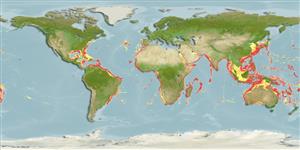Environment: milieu / climate zone / depth range / distribution range
Ecologie
marien benthopelagisch; diepte 9 - 1210 m (Ref. 9872), usually 200 - 500 m (Ref. 3583). Subtropical; 43°N - 35°S
Eastern Atlantic: Madeira and the Canary Islands to Senegal, Gulf of Guinea and South Africa. Western Atlantic: southern Scotian Shelf, Canada to Greater Antilles, western Caribbean, Panama and northern Gulf of Mexico (Ref. 7334). Indo-Pacific: off Natal (South Africa), Bay of Bengal, southern Australia, Chatham Plateau around New Zealand, and the Philippines (Ref. 4181). Also in northern South America (Moore, pers. comm.).
Grootte / Gewicht / Leeftijd
Maturity: Lm ? range ? - ? cm
Max length : 60.0 cm TL mannelijk / geslacht onbekend; (Ref. 3695); common length : 45.0 cm TL mannelijk / geslacht onbekend; (Ref. 3695)
Dorsale stekels (totaal) : 7 - 8; Dorsale zachte stralen (totaal) : 13 - 14; Anale stekels: 3; Anale zachte stralen: 11 - 12. Head with a concave forehead profile and with large mucous cavities covered by tough skin; mouth large and oblique; opercle and preopercle each with a large strong spine; body deep, about 2.1 times in SL; ventral keel with 10 - 14 very robust scutes; caudal fin forked but rounded. Color of head and body is dusky pink, sides with silvery tinge, fins red; tongue and gill cavity blackish; palate white to red (Ref. 7331). Pale beet red to light rosy. Back light red to brownish red, lower sides light silvery gray (Ref. 37108).
Lives close to or on the bottom of the upper continental slope. Prefers hard substrates. Young specimens feed on small shrimps and fish (Ref. 4784). A deep sea species, nonetheless, the young are often found near the coast (Ref. 9137). Utilized as fishmeal and source of oil in eastern central Atlantic (Ref. 3695).
Levenscyclus en paargedrag
Maturiteit | Voortplanting | Paaien | Eieren | Fecunditeit | Larven
Maul, G.E., 1990. Trachichthyidae. p. 620-622. In J.C. Quéro, J.C. Hureau, C. Karrer, A. Post and L. Saldanha (eds.) Check-list of the fishes of the eastern tropical Atlantic (CLOFETA). JNICT, Lisbon; SEI, Paris; and UNESCO, Paris. Vol. 2. (Ref. 3583)
Status op de Rode Lijst van het IUCN (Ref. 130435: Version 2024-1)
Gevaar voor de mens
Harmless
Gebruik door de mens
Visserij: commercieel; sportvis: ja
Tools
Speciale rapporten
Download XML
Internetbronnen
Estimates based on models
Preferred temperature (Ref.
123201): 8.1 - 18.7, mean 12.2 °C (based on 848 cells).
Fylogenetische diversiteitsindex (Ref.
82804): PD
50 = 0.7500 [Uniqueness, from 0.5 = low to 2.0 = high].
Bayesian length-weight: a=0.01514 (0.00885 - 0.02590), b=3.07 (2.91 - 3.23), in cm total length, based on LWR estimates for this species & (Sub)family-body (Ref.
93245).
Trofisch niveau (Ref.
69278): 3.9 ±0.65 se; based on food items.
Weerstandsvermogen (Ref.
120179): Zeer laag, minimale populatieverdubbelingstijd meer dan 14 jaar (Preliminary K or Fecundity.).
Fishing Vulnerability (Ref.
59153): Moderate vulnerability (44 of 100).
Nutrients (Ref.
124155): Calcium = 24.4 [10.0, 119.6] mg/100g; Iron = 0.646 [0.308, 1.494] mg/100g; Protein = 16.9 [15.5, 18.4] %; Omega3 = 0.319 [0.117, 0.902] g/100g; Selenium = 54.7 [19.5, 151.2] μg/100g; VitaminA = 24.7 [4.9, 138.9] μg/100g; Zinc = 0.632 [0.395, 1.045] mg/100g (wet weight);
